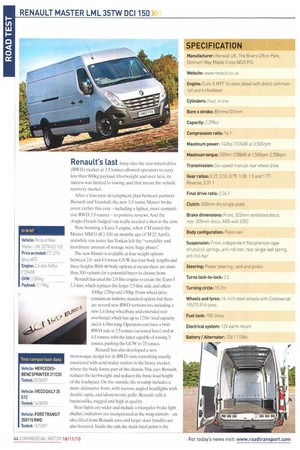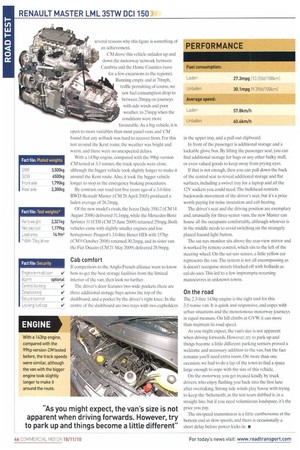Renault's last foray into the rear-wheel-drive (RWD) market at 3.5
Page 44

Page 45

Page 46

If you've noticed an error in this article please click here to report it so we can fix it.
tonnes allowed operators to carry less than 900kg payload. Overweight and over here, its success was limited to towing, and that meant the vehicle recovery market.
After a four-year development plan between partners Renault and Vauxhall, the new 3.5-tonne Master broke cover earlier this year including a lighter, more competi tive RWD 3.5-tonner to positive reviews. And the Anglo-French badged van really needed a shot in the arm.
Now boasting a Euro-5 engine, when CM tested the Master MM33 dCi 100 six months ago (CM 22 April), erstwhile van tester Ian Tonkin felt the "versatility and inordinate amount of storage were huge pluses': The new Master is available at four weight options between 2.8and 45-tonne G VW, has four body lengths and three heights. With 40 body options, it means there are more than 300 variants for a potential buyer to choose from.
Renault has used the 2.0-litre engine to create the Euro-5 2.3-litre, which replaces the larger 2.5-litre unit, and offers 100hp,125hp and 150hp. Front-wheel drive remains an industry standard option, hut there are several new RWD versions too, including a new L4 (long wheelbase and extended rear overhang), which has up to 173m load capacity and is 4.38m long. Operators can have a twin RWD axle at 3,5 tonnes (as tested here) and at 4.5 tonnes, with the latter capable of towing 3 tonnes, pushing the GCW to 75 tonnes.
Renault has also developed a new monocoque design for its RWD vans, something usually associated with semi-trailer reefers in the heavy market, where the body forms part of the chassis.This, says Renault, reduces the kerbweight and reduces the basic load height of the loadspace. On the outside, the revamp includes a more distinctive front, with narrow, angled headlights with double-optic, and idiosyncratic grille. Renault calls it businesslike, rugged and high in quality.
Rear lights are wider and include a triangular brake light display; indicators are incorporated in the wing mirrors an idea lifted from Renault cars; and larger door handles are also featured. Inside the cab, the main focal point is the amount of storage available — but more on that later. Standard kit includes radio/CD player with auxiliary input. Bluetooth, full steel bulkhead, and a seatback table that includes a swivel-laptop tray.
Prices start from £20,795 for front-wheel drive and £27. 245 for RWD. Options include air suspension, climate control, fixed cornering lights, dual-split under-seat storage. side airbags and a parking camera.
The basic list price for the Master LML 35.1Vv' dCi 150 is £27, 685, although it has many other options, such as: Convenience Plus, which includes air-con with pollen filter; one-touch driver's electric window and parking sensors, £750; clipboard holder, £70; digital tachograph, £575; dual-split under-seat storage, £30; 105-litre fuel tank, £30; and metallic paint (Star Grey), £330.
Productivity
It took a little effort. but CM was able to eke out 27,3mpg (fully laden) around the Kent van route, and there are several reasons why this figure is something of an achievement.
CM drove this vehicle unladen up and down the motorway network between Cumbria and the Home Counties (save for a few excursions to the regions). Running empty and at 70mph, traffic permitting of course, we saw fuel consumption drop to between 20mpg on journeys with side winds and poor weather, to 23mpg when the conditions were more favourable. As a big vehicle, it is open to more variables than most panel vans, and CM found that any setback was hard to recover from. For this test around the Kent route, the weather was bright and warm, and there were no unexpected delays.
With a 143hp engine, compared with the 99hp version CM tested at 3.3 tonnes, the track speeds were close, although the bigger vehicle took slightly longer to make it around the Kent route. Also, it took the bigger vehicle longer to stop in the emergency braking procedures. By contrast, our road test five years ago of a 3.0-litre RWD Renault Master (CM28 April 2005) produced a laden average of 26.2mpg.
Of the new model's rivals. the Iveco Daily 35S12 (CM14 August 2008) delivered 31.1mpg, while the Mercedes-Benz Sprinter 311CDI (CM 25 June 2009) returned 29mpg. Both vehicles came with slightly smaller engines and less horsepower. Peugeot's 3.0-litre Boxer HDi with 157hp (C' M9 October 2008) returned 30.2mpg, and its sister van the Fiat Ducat° (CM 21 May 2009) delivered 28.9mpg.
Cab comfort If competitors to the Anglo-French alliance want to know how to get the best storage facilities from the limited interior of the van, then look no further.
The driver's door features two wide pockets, there are three additional storage bays across the top of the dashboard, and a pocket by the driver's right knee. In the centre of the dashboard are two trays with two cupholders in the upper tray, and a pull-out clipboard.
In front of the passenger is additional storage and a lockable glove box. By lifting the passenger seat, you can find additional storage for bags or any other bulky stuff, or even valued goods to keep away from prying eyes.
If that is not enough, then you can pull down the back of the central seat to reveal additional storage and flat surfaces, including a swivel tray for a laptop and all the 12V sockets you could need. The bulkhead restricts backwards movement of the driver's seat, but ifs a price worth paying for noise insulation and cab heating.
The driver's seat and the driving position are exemplary and, unusually for three-seater vans, the new Master can house all the occupants comfortably, although whoever is in the middle needs to avoid switching on the strangely placed hazard light button.
The sat-nay monitor sits above the rear-view mirror and is worked by remote control, which sits to the left of the steering wheel. On the sat-nay screen, a little yellow car represents the van. The system is not all encompassing as it doesn't recognise streets blocked off with bollards as cul-de-sacs. This led to a few impromptu reversing manoeuvres in unknown towns.
On the road The 2.3-litre 143hp engine is the right tool for this 3.5-tonne van. It is quick and responsive, and copes with urban situations and the monotonous motorway journeys in equal measure. On hill climbs at GVW, it can more than maintain its road speed.
As you might expect, the van's size is not apparent when driving forwards. However, try to park up and things become a little different: parking sensors proved a welcome and necessary addition to the van, but the fact remains you'll need extra room. On more than one occasion, we had to do a lap of the town to find a space large enough to cope with the size of this vehicle.
On the motorway you get treated kindly by truck drivers, who enjoy flashing you back into the first lane after overtaking. Strong side winds play havoc with trying to keep the 'behemoth', as the test team dubbed it, in a straight line, but if you need voluminous loadspace, it's the price you pay.
The six-speed transmission is a little cumbersome at the bottom end at slow speeds, and there is occasionally a short delay before power kicks in. •




































































































































